Xiaofei Yang
SGMAGNet: A Baseline Model for 3D Cloud Phase Structure Reconstruction on a New Passive Active Satellite Benchmark
Sep 19, 2025Abstract:Cloud phase profiles are critical for numerical weather prediction (NWP), as they directly affect radiative transfer and precipitation processes. In this study, we present a benchmark dataset and a baseline framework for transforming multimodal satellite observations into detailed 3D cloud phase structures, aiming toward operational cloud phase profile retrieval and future integration with NWP systems to improve cloud microphysics parameterization. The multimodal observations consist of (1) high--spatiotemporal--resolution, multi-band visible (VIS) and thermal infrared (TIR) imagery from geostationary satellites, and (2) accurate vertical cloud phase profiles from spaceborne lidar (CALIOP\slash CALIPSO) and radar (CPR\slash CloudSat). The dataset consists of synchronized image--profile pairs across diverse cloud regimes, defining a supervised learning task: given VIS/TIR patches, predict the corresponding 3D cloud phase structure. We adopt SGMAGNet as the main model and compare it with several baseline architectures, including UNet variants and SegNet, all designed to capture multi-scale spatial patterns. Model performance is evaluated using standard classification metrics, including Precision, Recall, F1-score, and IoU. The results demonstrate that SGMAGNet achieves superior performance in cloud phase reconstruction, particularly in complex multi-layer and boundary transition regions. Quantitatively, SGMAGNet attains a Precision of 0.922, Recall of 0.858, F1-score of 0.763, and an IoU of 0.617, significantly outperforming all baselines across these key metrics.
Kimi K2: Open Agentic Intelligence
Jul 28, 2025Abstract:We introduce Kimi K2, a Mixture-of-Experts (MoE) large language model with 32 billion activated parameters and 1 trillion total parameters. We propose the MuonClip optimizer, which improves upon Muon with a novel QK-clip technique to address training instability while enjoying the advanced token efficiency of Muon. Based on MuonClip, K2 was pre-trained on 15.5 trillion tokens with zero loss spike. During post-training, K2 undergoes a multi-stage post-training process, highlighted by a large-scale agentic data synthesis pipeline and a joint reinforcement learning (RL) stage, where the model improves its capabilities through interactions with real and synthetic environments. Kimi K2 achieves state-of-the-art performance among open-source non-thinking models, with strengths in agentic capabilities. Notably, K2 obtains 66.1 on Tau2-Bench, 76.5 on ACEBench (En), 65.8 on SWE-Bench Verified, and 47.3 on SWE-Bench Multilingual -- surpassing most open and closed-sourced baselines in non-thinking settings. It also exhibits strong capabilities in coding, mathematics, and reasoning tasks, with a score of 53.7 on LiveCodeBench v6, 49.5 on AIME 2025, 75.1 on GPQA-Diamond, and 27.1 on OJBench, all without extended thinking. These results position Kimi K2 as one of the most capable open-source large language models to date, particularly in software engineering and agentic tasks. We release our base and post-trained model checkpoints to facilitate future research and applications of agentic intelligence.
RSRWKV: A Linear-Complexity 2D Attention Mechanism for Efficient Remote Sensing Vision Task
Mar 26, 2025



Abstract:High-resolution remote sensing analysis faces challenges in global context modeling due to scene complexity and scale diversity. While CNNs excel at local feature extraction via parameter sharing, their fixed receptive fields fundamentally restrict long-range dependency modeling. Vision Transformers (ViTs) effectively capture global semantic relationships through self-attention mechanisms but suffer from quadratic computational complexity relative to image resolution, creating critical efficiency bottlenecks for high-resolution imagery. The RWKV model's linear-complexity sequence modeling achieves breakthroughs in NLP but exhibits anisotropic limitations in vision tasks due to its 1D scanning mechanism. To address these challenges, we propose RSRWKV, featuring a novel 2D-WKV scanning mechanism that bridges sequential processing and 2D spatial reasoning while maintaining linear complexity. This enables isotropic context aggregation across multiple directions. The MVC-Shift module enhances multi-scale receptive field coverage, while the ECA module strengthens cross-channel feature interaction and semantic saliency modeling. Experimental results demonstrate RSRWKV's superior performance over CNN and Transformer baselines in classification, detection, and segmentation tasks on NWPU RESISC45, VHR-10.v2, and GLH-Water datasets, offering a scalable solution for high-resolution remote sensing analysis.
DCT-Mamba3D: Spectral Decorrelation and Spatial-Spectral Feature Extraction for Hyperspectral Image Classification
Feb 04, 2025



Abstract:Hyperspectral image classification presents challenges due to spectral redundancy and complex spatial-spectral dependencies. This paper proposes a novel framework, DCT-Mamba3D, for hyperspectral image classification. DCT-Mamba3D incorporates: (1) a 3D spectral-spatial decorrelation module that applies 3D discrete cosine transform basis functions to reduce both spectral and spatial redundancy, enhancing feature clarity across dimensions; (2) a 3D-Mamba module that leverages a bidirectional state-space model to capture intricate spatial-spectral dependencies; and (3) a global residual enhancement module that stabilizes feature representation, improving robustness and convergence. Extensive experiments on benchmark datasets show that our DCT-Mamba3D outperforms the state-of-the-art methods in challenging scenarios such as the same object in different spectra and different objects in the same spectra.
3D Question Answering for City Scene Understanding
Jul 24, 2024Abstract:3D multimodal question answering (MQA) plays a crucial role in scene understanding by enabling intelligent agents to comprehend their surroundings in 3D environments. While existing research has primarily focused on indoor household tasks and outdoor roadside autonomous driving tasks, there has been limited exploration of city-level scene understanding tasks. Furthermore, existing research faces challenges in understanding city scenes, due to the absence of spatial semantic information and human-environment interaction information at the city level.To address these challenges, we investigate 3D MQA from both dataset and method perspectives. From the dataset perspective, we introduce a novel 3D MQA dataset named City-3DQA for city-level scene understanding, which is the first dataset to incorporate scene semantic and human-environment interactive tasks within the city. From the method perspective, we propose a Scene graph enhanced City-level Understanding method (Sg-CityU), which utilizes the scene graph to introduce the spatial semantic. A new benchmark is reported and our proposed Sg-CityU achieves accuracy of 63.94 % and 63.76 % in different settings of City-3DQA. Compared to indoor 3D MQA methods and zero-shot using advanced large language models (LLMs), Sg-CityU demonstrates state-of-the-art (SOTA) performance in robustness and generalization.
Multi-Task Domain Adaptation for Language Grounding with 3D Objects
Jul 03, 2024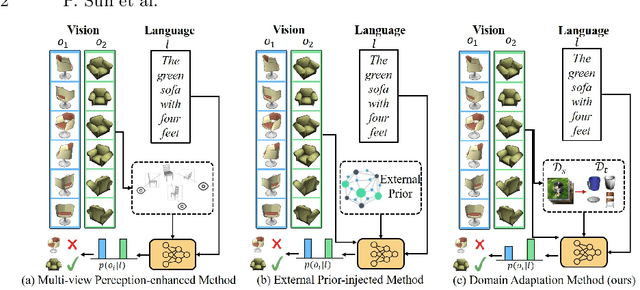
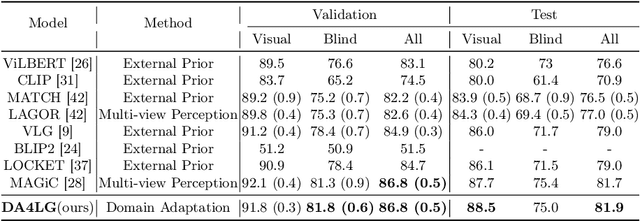
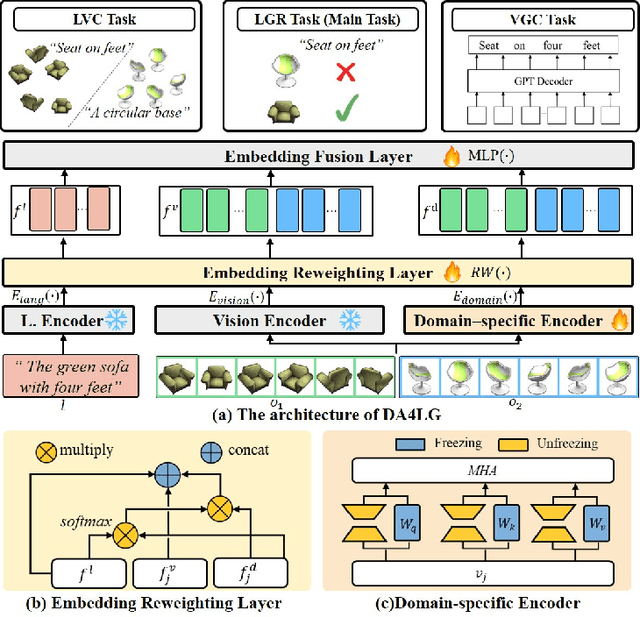

Abstract:The existing works on object-level language grounding with 3D objects mostly focus on improving performance by utilizing the off-the-shelf pre-trained models to capture features, such as viewpoint selection or geometric priors. However, they have failed to consider exploring the cross-modal representation of language-vision alignment in the cross-domain field. To answer this problem, we propose a novel method called Domain Adaptation for Language Grounding (DA4LG) with 3D objects. Specifically, the proposed DA4LG consists of a visual adapter module with multi-task learning to realize vision-language alignment by comprehensive multimodal feature representation. Experimental results demonstrate that DA4LG competitively performs across visual and non-visual language descriptions, independent of the completeness of observation. DA4LG achieves state-of-the-art performance in the single-view setting and multi-view setting with the accuracy of 83.8% and 86.8% respectively in the language grounding benchmark SNARE. The simulation experiments show the well-practical and generalized performance of DA4LG compared to the existing methods. Our project is available at https://sites.google.com/view/da4lg.
FPS-Net: A Convolutional Fusion Network for Large-Scale LiDAR Point Cloud Segmentation
Mar 01, 2021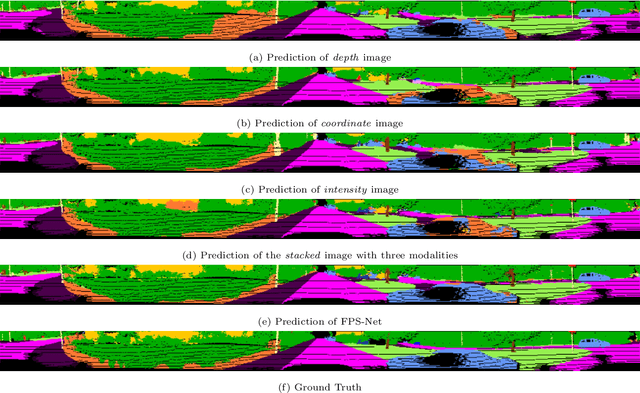


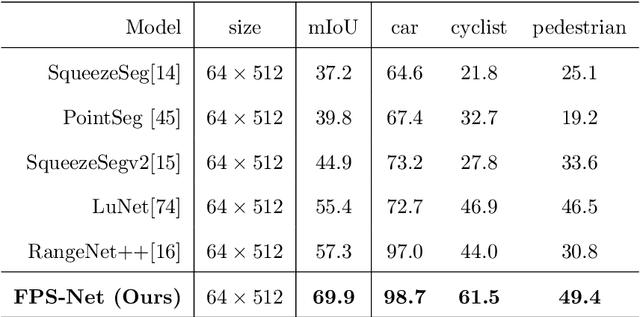
Abstract:Scene understanding based on LiDAR point cloud is an essential task for autonomous cars to drive safely, which often employs spherical projection to map 3D point cloud into multi-channel 2D images for semantic segmentation. Most existing methods simply stack different point attributes/modalities (e.g. coordinates, intensity, depth, etc.) as image channels to increase information capacity, but ignore distinct characteristics of point attributes in different image channels. We design FPS-Net, a convolutional fusion network that exploits the uniqueness and discrepancy among the projected image channels for optimal point cloud segmentation. FPS-Net adopts an encoder-decoder structure. Instead of simply stacking multiple channel images as a single input, we group them into different modalities to first learn modality-specific features separately and then map the learned features into a common high-dimensional feature space for pixel-level fusion and learning. Specifically, we design a residual dense block with multiple receptive fields as a building block in the encoder which preserves detailed information in each modality and learns hierarchical modality-specific and fused features effectively. In the FPS-Net decoder, we use a recurrent convolution block likewise to hierarchically decode fused features into output space for pixel-level classification. Extensive experiments conducted on two widely adopted point cloud datasets show that FPS-Net achieves superior semantic segmentation as compared with state-of-the-art projection-based methods. In addition, the proposed modality fusion idea is compatible with typical projection-based methods and can be incorporated into them with consistent performance improvements.
RRCN: A Reinforced Random Convolutional Network based Reciprocal Recommendation Approach for Online Dating
Nov 25, 2020



Abstract:Recently, the reciprocal recommendation, especially for online dating applications, has attracted more and more research attention. Different from conventional recommendation problems, the reciprocal recommendation aims to simultaneously best match users' mutual preferences. Intuitively, the mutual preferences might be affected by a few key attributes that users like or dislike. Meanwhile, the interactions between users' attributes and their key attributes are also important for key attributes selection. Motivated by these observations, in this paper we propose a novel reinforced random convolutional network (RRCN) approach for the reciprocal recommendation task. In particular, we technically propose a novel random CNN component that can randomly convolute non-adjacent features to capture their interaction information and learn feature embeddings of key attributes to make the final recommendation. Moreover, we design a reinforcement learning based strategy to integrate with the random CNN component to select salient attributes to form the candidate set of key attributes. We evaluate the proposed RRCN against a number of both baselines and the state-of-the-art approaches on two real-world datasets, and the promising results have demonstrated the superiority of RRCN against the compared approaches in terms of a number of evaluation criteria.
 Add to Chrome
Add to Chrome Add to Firefox
Add to Firefox Add to Edge
Add to Edge